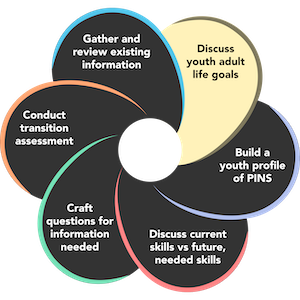Age-Appropriate Transition Assessment Planning Guide
Example of Career Discussion
For example, a youth could express a goal to become a brain surgeon, but the youth is not taking appropriate science and anatomy courses, being comfortable with blood, or wanting to go to college for several years. When the team had more discussions about 'the why' for this goal, it was discovered the youth had several brain surgeries himself and really enjoyed his time with his doctor, the nurses, and how they ultimately made him feel better. He articulated that he wanted to make others feel better too.
This opens the team's eyes to help the youth explore different fields where he can experience that same feeling of helping others. By showing the extent of the skills, experience, and education needed for a youth's adult life goal, it may help them focus on the items needed to reach it. In the same example, it may allow the youth to choose to take more difficult high school science courses next semester, focus on their academics more seriously, and ultimately raise the expectations of themselves to get on the path to their adult life goals.
We have seen first hand how documenting the steps needed to reach a goal can both foster more discussion on what the goal truly means to the youth and also how crystalizing the many steps to a goal allows the youth to maximize their potential and reach their adult life goals. The discussion about a youth's adult life goals should focus on the facts (skills, education, and experiences needed to reach it) and not about any team member's opinion on whether or not the student can achieve it.
This is the intended purpose of AATA to allow the youth and team to gather necessary data and information. This step becomes an opportunity for all team members to support the youth, raise expectations for all, and help them reach their adult life goals.
